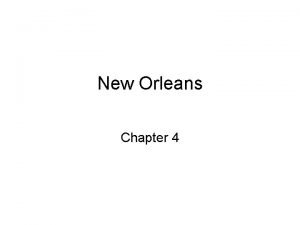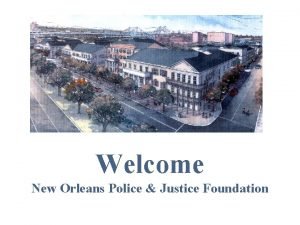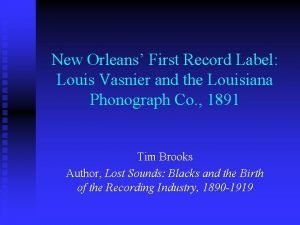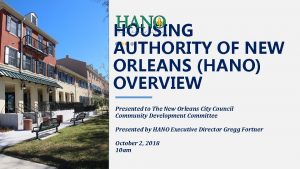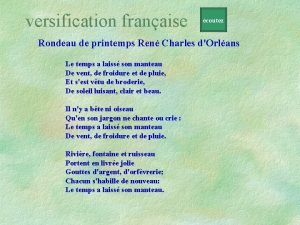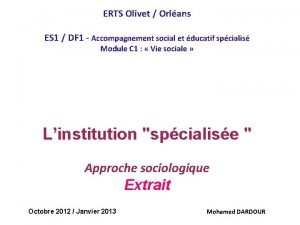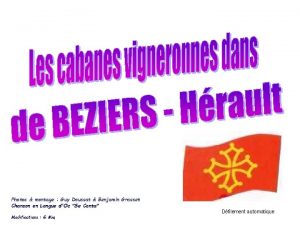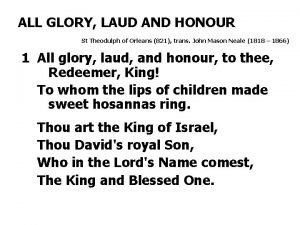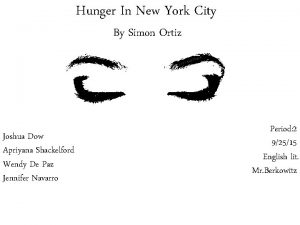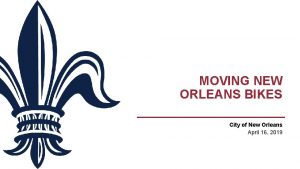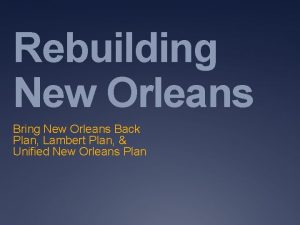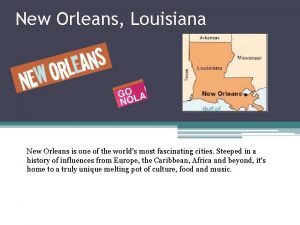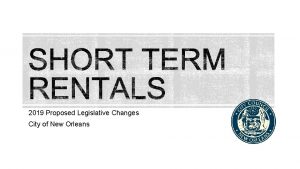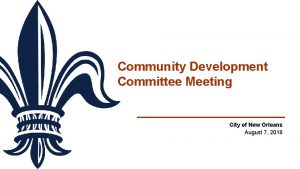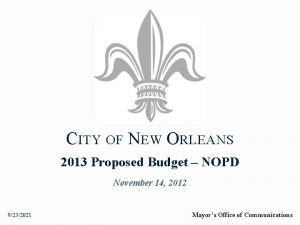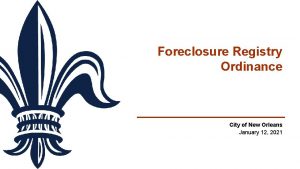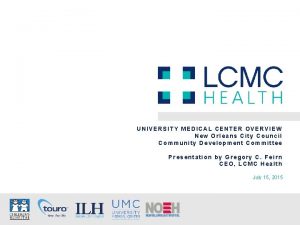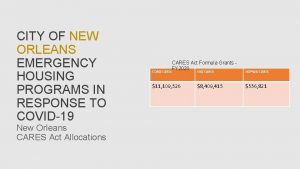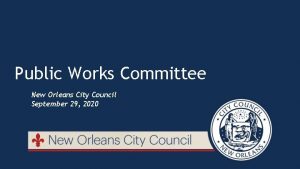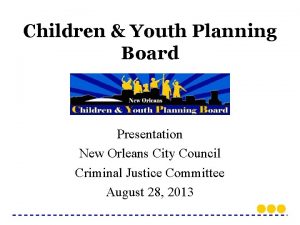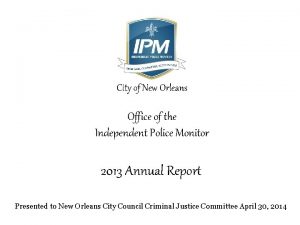New Orleans Chapter 4 The City on the


















































- Slides: 50

New Orleans Chapter 4

The City on the Gulf • Jazz comes from a mixture of African, European, and Caribbean experiences, but it started out as a local musical practice in New Orleans jazz transformed marching band dance music into an improvised, playfully voiced, cyclic, polyphonic music played over a steady dance beat using collective improvisation.

The City on the Gulf • Creoles of Color and Uptown Negroes – The demographics of New Orleans also contributed to the creation of jazz because it was a site characterized by the mingling of newly urbanized blacks with Europeanized Creoles. New Orleans musicians eventually moved to other parts of the United States, such as Chicago, New York, and California, as part of the Great Migration.

The City on the Gulf • Creoles of Color and Uptown Negroes …At the same time, the burgeoning record industry made New Orleans jazz available in diverse geographical and sociocultural contexts.

The City on the Gulf • Creoles of Color and Uptown Negroes – New Orleans is a port city. It became a nineteenth-century commercial center focusing on the slave trade on the one hand, with a distinct, more relaxed Caribbean culture on the other. A brief history: • • 1718: founded by France 1763: sold to Spain 1803: reclaimed by the French 1803: almost immediately sold to the United States

The City on the Gulf • Creoles of Color and Uptown Negroes – New Orleans had French, Spanish, and English speakers and was the largest, most sophisticated city in the South. This included an active cultural life from the eighteenth century, encompassing opera, Mardi Gras, dances, parades, and fancy balls.

The City on the Gulf • Creoles of Color and Uptown Negroes – Race relations were different from those in other parts of the United States. Unlike Protestant North America, New Orleans was oriented to the Caribbean, and like racial practices there, slaves were allowed to retain much of their culture, including music.

The City on the Gulf • Creoles of Color and Uptown Negroes – North American culture recognized two categories: white and black. Caribbean culture, including New Orleans, recognized a mulatto culture as well. This benefited free blacks with lighter skins.

The City on the Gulf • Creoles of Color and Uptown Negroes – New Orleans mulattos were known as Creoles of Color. Because they were of mixed race, they had privileges and opportunities that blacks did not, including civic power, property ownership, French language skills, Catholic religious practice, decent education, and skilled trades. Creoles lost this status around 1894 with the enactment of Jim Crow laws and U. S. Supreme Court decisions in 1896.

The City on the Gulf • Creoles of Color and Uptown Negroes – Creoles tried to remain geographically separate from blacks by keeping to an area of the city east of Canal Street including the French Quarter. Blacks lived “uptown, ” on the other side of Canal. But Jim Crow laws forced the two traditions to collide.

The City on the Gulf • Creoles of Color and Uptown Negroes – Uneducated “Uptown Negroes” played raucous, beat-based, orally learned, bluesy, improvised music based on rags, folk music, and marches. Creoles saw this as unprofessional, but they started teaching uptown blacks as well as young Creoles.

The City on the Gulf • Creoles of Color and Uptown Negroes – At first Creoles got the better-paying jobs playing traditional European dances, but blacks eventually came to offer a new, alternative way of playing that appealed to audiences for different reasons.

The City on the Gulf • Buddy Bolden (1877– 1931) and the Birth of Jazz – Although there are many myths about cornetist Buddy Bolden, it is generally accepted that he was the first important jazz musician, had a large black and Creole following, and represents the triumph of African American culture.

The City on the Gulf • Buddy Bolden (1877– 1931) and the Birth of Jazz • 1877: born in New Orleans • 1895: started working in parades and other functions • 1901– 1902: went into music full time • 1906: experienced a mental breakdown after years of depression and alcoholism; incarcerated in state hospital for the insane • 1931: died in the hospital

The City on the Gulf • Known for loud and great blues playing. Unlike other New Orleans musicians, who were generally known for their musicianship and clarity, Bolden was known for his individual style. Combine this with his brief career, excessive lifestyle, competitive spirit, and charisma, and the template for later jazz and popular music stars coalesces.

The City on the Gulf • Did Bolden invent jazz? He was known as an innovator of a new way of playing; no precursors or contemporary rivals are mentioned. He could play in every setting at a time when there was a huge demand for a wide range of music.

The City on the Gulf • Bolden seemed to have been respected for playing successfully in most forms of popular music—“legitimate” music and otherwise. He also played pieces that have remained part of the jazz repertory, sentimental pop, and dance music.

The City on the Gulf • He led many bands, with the best known in 1905, consisting of cornet, trombone, two clarinetists, a guitarist, a bassist, and a drummer. Sometimes a second cornet was added, foreshadowing King Oliver’s band with Louis Armstrong.

The City on the Gulf • New Orleans Style – Between the time of Bolden and the first jazz recording in 1917, jazz continued to develop. Photos and interviews give us a picture of this stage.

The City on the Gulf • New Orleans Style – Instrumentation • There were two groupings of instruments. – First, brass bands provided the “front line” of cornet or trumpet, trombone, and clarinet, as well as the drum set. – Second, the string ensemble (violin, banjo, mandolin, etc. ) provided guitar and bass. Ragtime players added piano later.

The City on the Gulf • New Orleans Style • At first, a violin played an unadorned melody against which the cornet “ragged” the melody, but by 1917, the violin had disappeared. Now the clarinet improvised a countermelody around the trumpet line (originally taken from published arrangements), using the underlying harmony. The trombone improvised a line lower than the trumpet and with fewer notes (and originally played cello or baritone horn parts). It typically uses long glissandos called tailgate trombone.

The City on the Gulf • New Orleans Style – Improvisation • By the time New Orleans jazz was first recorded, it had attained its own distinctive style of collective improvisation, with each wind instrument having its own musical space and rhythm: clarinet was the fastest and pitched higher than the cornet; the cornet was in the middle; and trombone was the slowest and below the cornet.

The City on the Gulf • New Orleans Style • Occasionally there were other textures as well. – The trio part of a performance often contained block chord texture or a single horn with accompaniment, breaks, and stop-time. – The rhythm section played an even four, although this is difficult to hear due to recording technology of the time.

The City on the Gulf • New Orleans Style – Form • Mostly the form was the same as ragtime. At the end, the last strain would be repeated many times. A new structure was the 12 -bar blues. This could be repeated indefinitely.

The City on the Gulf • Storyville – “The District” in New Orleans, where prostitution was legal, lasted until 1917. Bordellos could be mansions or shacks. The purported link between jazz and Storyville is widespread but wrong. At most, there were a few pianists who worked the bordellos.

The City on the Gulf • Storyville …Many jazz musicians worked in Storyville cabarets, but they also worked in parks, parades, excursions, advertising wagons, and riverboats and for dances throughout the city.

The City on the Gulf • Storyville – But Storyville did play a role. It was a rough area where white values of taste were absent. This made it easier for musicians to develop expressive techniques, slow tempos (for sexy, slow dances), and timbre variation.

The City on the Gulf • The Great Migration – In the late nineteenth century, former slaves started to move into cities like New Orleans. With the onset of World War I, they moved north to places like Chicago and New York.

The City on the Gulf • The Great Migration – They were socially motivated by their powerlessness, the discriminatory practices of sharecropping, widespread racial segregation touching practically all areas of life in the South, and thousands of lynchings for which nobody was arrested. – Economically, the draft during World War I opened up the labor market in northern cities for blacks.

The City on the Gulf • Jazz Moves On: First Recordings – Freddie Keppard (1890– 1933) • Southern entertainers led the charge north. Trumpeter Keppard played all over the United States with his band, the Creole Jazz Band, before 1917. By doing so, he brought New Orleans jazz to the rest of the country. • He was offered an opportunity to record in 1916 but declined.

The City on the Gulf • Jazz Moves On: First Recordings – Original Dixieland Jazz Band • The white ODJB came to New York to play at Riesenweber’s Restaurant in 1917. They were a sensation.

The City on the Gulf • Jazz Moves On: First Recordings • Victor signed them to record two pieces, “Livery Stable Blues” and “Dixie Jazz Band One Step, ” which turned out to be blockbusters. Although previous ragtime records had hinted at some jazz elements, to most listeners, ODJB’s music was unprecedented. They were so popular that they brought the word “jazz” into common parlance.

The City on the Gulf • Jazz Moves On: First Recordings • Origins – Many New Orleans neighborhoods were integrated, and thus white players became familiar with ragtime and jazz in New Orleans and probably influenced black players in terms of repertory, harmony, and instrumental technique. The five-piece format of the ODJB comes from the Keppard band. – There is a significant white tradition centered around “Papa Jack” Laine, who led the Reliance Band. He discouraged improvisation but trained many important white players including members of the ODJB.

The City on the Gulf • Jazz Moves On: First Recordings • Influence – The ODJB has been labeled as mediocre. But they played a spirited, unpretentious music that established many Dixieland standards, broke with ragtime, and, by visiting Europe in 1919, made jazz international. The group dissolved in 1922.

The City on the Gulf • Jazz Moves On: First Recordings – Jelly Roll Morton (1890– 1941) • Jazz history can be seen as a mutually influencing relationship between composers and improvisers, as is the relationship between Creoles and blacks in the creation of jazz. Morton fits right in as a Creole composer who learned from and worked with black New Orleans musicians.

The City on the Gulf • Jazz Moves On: First Recordings • Morton had many jobs and claimed to be the inventor of jazz. He was proud of his French Haitian heritage but Anglicized his name from La. Mothe to Morton. His boasting alienated many in the jazz world including Duke Ellington. He may not have invented jazz, but he did propel it forward.

The City on the Gulf • Jazz Moves On: First Recordings • He traveled widely, assimilating new musical approaches. He settled in Chicago in 1922 and started recording in 1923 with a white New Orleans band called the New Orleans Rhythm Kings (NORK) for Gennett Records in Richmond, Indiana; this was the first important integrated recording. He introduced some of his originals, including future standards such as “King Porter Stomp. ”

The City on the Gulf • Jazz Moves On: First Recordings • The Red Hot Peppers – Morton became a successful songwriter. To help increase interest in his work, Victor started recording his studio band of seven or eight players (The Red Hot Peppers) in 1926, when recording was switching from acoustic to electric recording. For many they represent a perfect balance of improvisation and composition in the New Orleans style.

The City on the Gulf • Jazz Moves On: First Recordings • “Dead Man Blues” – A number of blues choruses in collective New Orleans style, this is Morton’s take on the New Orleans burial ritual. This is highly organized with even the bass lines written out. There is also an overlay of ragtime structure with various sets of choruses as ragtime strains. • By 1930, he was considered outdated. In 1938 he made some important recorded interviews with Alan Lomax for the Library of Congress.

The City on the Gulf • Jazz Moves On: First Recordings – King Oliver (1885– 1938) • By 1922 jazz musicians had matured, writing many new pieces and demonstrating increased instrumental technique. But jazz had also become associated with gimmickry and comedy. King Oliver resisted this last turn.

The City on the Gulf • Jazz Moves On: First Recordings • In 1905 Oliver started playing cornet in brass bands and saloon groups, before joining trombonist Kid Ory’s band in 1917. Oliver was known for his use of various mutes, a practice that was very influential.

The City on the Gulf • Jazz Moves On: First Recordings • King Oliver’s Creole Jazz Band – Oliver organized many different kinds of bands depending on the specific job. In 1918 he moved to Chicago and spent several years on the road until 1922 to play at a high-end, black-owned nightclub, the Lincoln Gardens. His band was made up of New Orleans musicians except for the pianist, Lil Hardin. Oliver had gum disease, which meant he required a second cornetist to back up his playing, so he sent for his old student, Louis Armstrong.

The City on the Gulf • Jazz Moves On: First Recordings – They were a great success. Black and white musicians came to hear the uptown style of this band. The band’s recordings from this period exhibit a mature New Orleans collective style. In 1923 they recorded for Gennett in Richmond, Indiana—then a hotbed for the Ku Klux Klan —using stop-time, breaks, and an improvised, polyphonic “first line. ” – “Dippermouth Blues” also includes solos by clarinetist Johnny Dodds and Louis Armstrong and a widely imitated one by King Oliver using mutes.

The City on the Gulf • Jazz Moves On: First Recordings • Not unlike Morton and other early jazz figures, Oliver was soon surpassed by new styles and younger players. By 1935 he could no longer play and died in poverty soon thereafter. – Gennett Records • Gennett was owned by a piano-manufacturing company. The studio was made of wood planks with one megaphone that recorded acoustically, so the musicians had to position themselves in the room to create a musical balance.

The City on the Gulf • Jazz Moves On: First Recordings – “Snake Rag” • As per the title, this has a ragtime structure but also includes bluesy breaks, chromatic melodies (or “snakes”), a repeated trio section (which is used to build excitement), and the signature Armstrong-Oliver “improvised” duo breaks.

The City on the Gulf • Jazz Moves On: First Recordings – Sidney Bechet (1897– 1959) • Clarinetist and soprano saxophonist Bechet may have been the first great jazz improviser. He made the saxophone central to jazz and also traveled abroad during the 1920 s spreading this new music.

The City on the Gulf • Jazz Moves On: First Recordings • Born a Creole, Bechet mostly taught himself the clarinet. He ended up playing in many of the important marching bands. In 1916 he started touring, taking him to Chicago in 1919. There he attracted the attention of composer, songwriter, classical violinist, and bandleader Will Marion Cook, who recruited Bechet into his band, the Southern Syncopated Orchestra, for their European tour. There were some important results from this tour:

The City on the Gulf • Jazz Moves On: First Recordings – Bechet bought his first soprano saxophone in London. – The band inspired the first serious jazz essay, which was penned by conductor Ernest Ansermet and praised Bechet’s playing. – This tour popularized jazz in Europe, and though he opted to stay abroad, Bechet was deported in 1921 following an unfortunate incident in London.

The City on the Gulf • Jazz Moves On: First Recordings • In 1921 Bechet teamed up with New Orleans pianist, composer, song-publisher, and record producer Clarence Williams and recorded with Clarence Williams’s Blue Five. In the group’s 1924 recording of “Cake Walking Babies (from Home), ” Bechet proved himself to be the only musician of that era who could rival the talented, up-andcoming Armstrong.

The City on the Gulf • Jazz Moves On: First Recordings • He settled in France in 1951 and remained the soprano saxophone’s chief exponent until his death in 1959. – The New Orleans style is still alive at Preservation Hall bands in New Orleans and in bands all over the world devoted to Dixieland jazz.
 Chapter 4 new orleans
Chapter 4 new orleans When the lights all shine
When the lights all shine New orleans police foundation
New orleans police foundation Relative location of new orleans
Relative location of new orleans Hurricane gustav timeline
Hurricane gustav timeline My family lives at 3904 canal street in new orleans
My family lives at 3904 canal street in new orleans Record label in new orleans
Record label in new orleans Rolls royce rental houston
Rolls royce rental houston Hano housing choice voucher program
Hano housing choice voucher program Hannah rochelle
Hannah rochelle Lsu pediatrics residency
Lsu pediatrics residency Aag new orleans
Aag new orleans Air mixed gas surface supplied diving new orleans
Air mixed gas surface supplied diving new orleans New orleans public works
New orleans public works Port of new orleans
Port of new orleans New orleans independent police monitor
New orleans independent police monitor Katrina tornade
Katrina tornade New orleans department of public works
New orleans department of public works Le temps a laissé son manteau analyse
Le temps a laissé son manteau analyse Orleans hanna algebra prognosis test
Orleans hanna algebra prognosis test Erts olivet
Erts olivet Sconet orleans tours
Sconet orleans tours Cave de benjamin orleans
Cave de benjamin orleans St theodulph of orleans
St theodulph of orleans Hystéroscopie chirurgicale orleans
Hystéroscopie chirurgicale orleans American city model
American city model Cbd inner city suburbs
Cbd inner city suburbs Primate cities
Primate cities Chapter 16 toward a new heaven and a new earth
Chapter 16 toward a new heaven and a new earth New city college
New city college Hunger in new york city poem
Hunger in new york city poem City of new braunfels gis
City of new braunfels gis Why is new york called the big apple
Why is new york called the big apple New city primary school
New city primary school New york city technology forum
New york city technology forum Nyc department of youth
Nyc department of youth New york city college of technology
New york city college of technology New smyrna beach utility commission
New smyrna beach utility commission Why do some brains enjoy fear allegra ringo summary
Why do some brains enjoy fear allegra ringo summary New city
New city New city
New city Siting
Siting How would you describe the new capital city nara
How would you describe the new capital city nara Event new york
Event new york Research alliance for nyc schools
Research alliance for nyc schools How would you describe the new capital city, nara?
How would you describe the new capital city, nara? Pmi new york city
Pmi new york city Hát kết hợp bộ gõ cơ thể
Hát kết hợp bộ gõ cơ thể Lp html
Lp html Bổ thể
Bổ thể Tỉ lệ cơ thể trẻ em
Tỉ lệ cơ thể trẻ em
